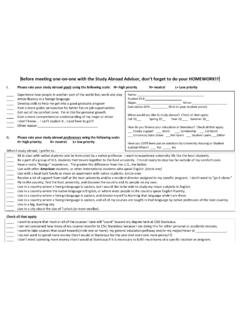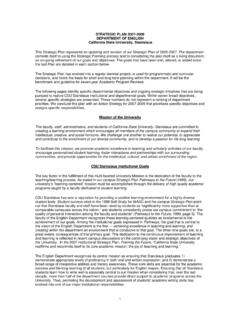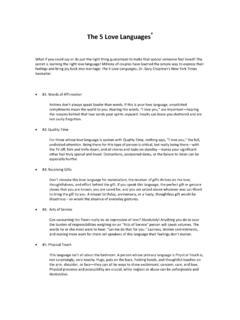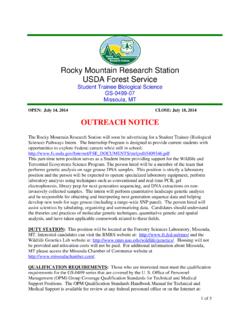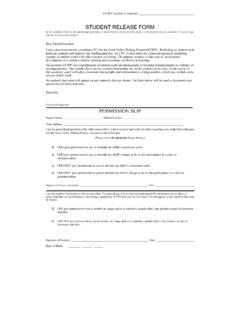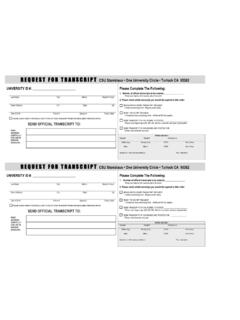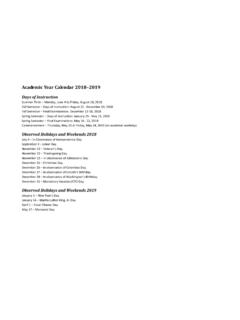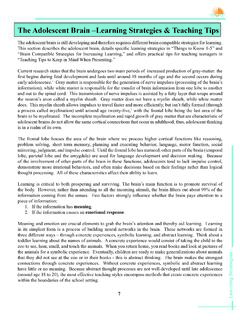Transcription of Survival Skills - California State University Stanislaus
1 Survival Skills 101>> You won t find the key to outdoor Survival in a fancy first-aid kit. Or on page 236 of a dusty manual. Nope, your ability to adapt and endure is dependent on what s stored inside your head. In the following pages, we ll help you upgrade your Survival smarts with inventive advice on staying warm, dry, hydrated, and focused as you negotiate any do-or-die Jason Stevenson and Alison FrommeEverything you need to know to get out of trouble fastView Index Print ExitBACKPACKER : Survival Skills 1012>> Leave your itinerary with a trusted friend or family member, along with a designated call-in time for your return.
2 >> Describe your car and where you ll park.>> Register at the appropriate park office or trailhead kiosk.>> Put a note on your dashboard, detailing your route and estimated return time.>> Bring all necessary maps or photocopy the essential map pages from a book.>> Pack a signaling device, such as a whistle or mirror.>> Carry a reliable fire starter, such as a butane lighter or flint striker.>> Determine an emergency bearing to hike to a road or a town.>> Do a gear shakedown at the trailhead, if you re in a You Go:CONTENTSThou Shalt Not Panic ..3 Lead Us into Salvation ..4 Edible Plants.
3 4 How to ..5 Quick Clinic ..7 Backcountry Shelters ..8 Knots to Know ..9 Was Lost, Now I m Found ..10 View Index Print ExitBACKPACKER : Survival Skills 1013 How to avoid a potentially crippling response to emergenciesYou hear the crunch of snapping bones a second before pain flares up your leg. You look down; a gopher hole has wrecked your ankle, turning a pleasant solo hike into a Survival epic. Fear surges through your brain , and your body begins to shake. What s going on?Know the symptoms Panic is both a physical and a mental reaction, and it can occur independent of shock. You re likely to experience an adrenaline spike, muscle trembling, throat constriction, hyperventilation, loss of fine motor Skills , nausea, and/or dizziness.
4 Your mind may react with hallucinations, irritability, and a movie reel of worst-case scenarios culminating in your death. These responses can spiral out of control and cloud your your emotions Anxiety is fueled by catastrophic thoughts, says Jonathan Abramowitz, a professor of psychology at the University of North Carolina at ChapelHill. To check the spiral, sit down and breathe deeply. Tackle a right- brain task, like taping your logic Once you ve calmed down, you need to analyze your situation and think rationally, says Abramowitz. Instead of trying to solve the emergency all at once, focus on one small task at a time.
5 Eat. Drink. Look for shelter. Study your map for escape routes and water sources. Test your ankle. If it doesn t work, pitch your tent. Collect wood. Build a signal fire. And so the positive Don t worry about the distance to your car, recommends Gino Ferri, author of The Psychology of Wilderness Survival . Remind yourself of your training, and repeat a helpful phrase such as, I can do this. Think about family and friends, and the story you ll tell about this Shalt Not PanicView Index Print ExitBACKPACKER : Survival Skills 1014 Lead Us into SalvationTaking charge in a crisis is more art than scienceSpeak up It takes a lot of courage not to get swept along by a group, says John Graham, mountaineer and author of Outdoor Leadership.
6 Graham almost died when rough water knocked him off his feet during a river crossing in Denali National Park in Alaska. He now realizes the incident could have been averted if someone had said, Hey, this risk isn t worth it. Express empathy When bad things happen, there s a clear correlation between staying calm and surviving, Graham says. If someone in your group freezes on narrow ledge, show concern for your panicked com-rade. Speak softly, make eye contact, explain the situation honestly, and describe the options, he advises. Your friend may be embarrassed as well as scared, so discourage others from gawking or offering conflicting advice.
7 Take command If your group is falling apart, there s no time to take a poll on what to do, Graham says. The more immediate the danger a lightning storm on a high ridge, for example the less group harmony matters. Sometimes top-down leadership is needed, but that doesn t mean barking orders. Instead, lead with quiet but firm instructions and ask for group input only when time allows, or after the crisis treeCut and boil needles for tea rich in vitamin C; eat the protein-rich brown-and-yellow pollen cones in PlantsAcornBoil to remove bitter tannins. Those from white oaks (rounded leaves) and pin oaks (pointy leaves) are less the cucumber-like cores of young shoots, or mash the starch-filled rhizomes (horizontal rootstalks).
8 CloverThese sweet-tasting leaves and roots can be eaten raw or steamed like and eat the young green leaves, or boil the dried white flowers for a bitter , peel, and boil the stems; the white petals and thumb-sized fruits can be eaten raw during the Index Print ExitBACKPACKER : Survival Skills 1015 Find a natural bandageGather dried sphagnum moss soft, bushy, green clumps from bogs or swamps. WWI soldiers used it to stanch their wounds because it s antibacterial and as absorbent as cotton. Press it against a bleeding wound, or bind it on top of a sterile pad after the blood biting insects Seek out windy spots, or apply mud to exposed skin.
9 Rub flakes of birchbark on your skin and clothing the oil repels bugs. Mosquitoes are attracted to wet and dark-colored clothing, as well as to perspiration. They are most active at dawn and dusk, when the air is a coral snakeRemember: Red on yellow, kill a fellow. Red on black, friend of Jack. Poisonous coral snakes, with adjacent red and yellow bands and a black head, live predominantly in the Southeast and Southwest. Similar-looking scarlet king snakes, with their adjacent red and black bands, are harmless constrictors that range from Florida to New Jersey. Rewarm frostbitten skinPlace the white, waxy frozen skin in lukewarm water or apply hot, wet cloths until it becomes pink as blood flow returns.
10 Never apply dry heat; frostbitten skin burns easily. To avoid damaging tissue, don t rub or massage skin. Taking ibuprofen manages pain and can reduce the chance of blood cold feetSwing your leg forcefully back and forth, like a pendulum. Inertia will force the blood to the tips of your your distance traveledThe average footstep is 30 inches, and a fit person can walk 3 mph over flat ground. Determining how far you ve walked is critical for navigating through a whiteout or dense forest or if you re trying to pinpoint the exact location of a trail junction or north using a clock faceHold an analog watch flat, with the hour hand aimed at the sun.


